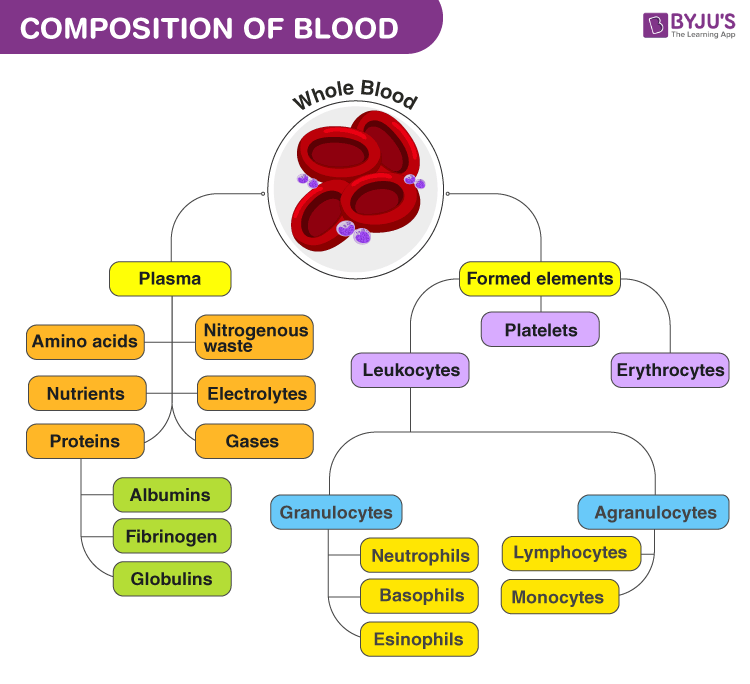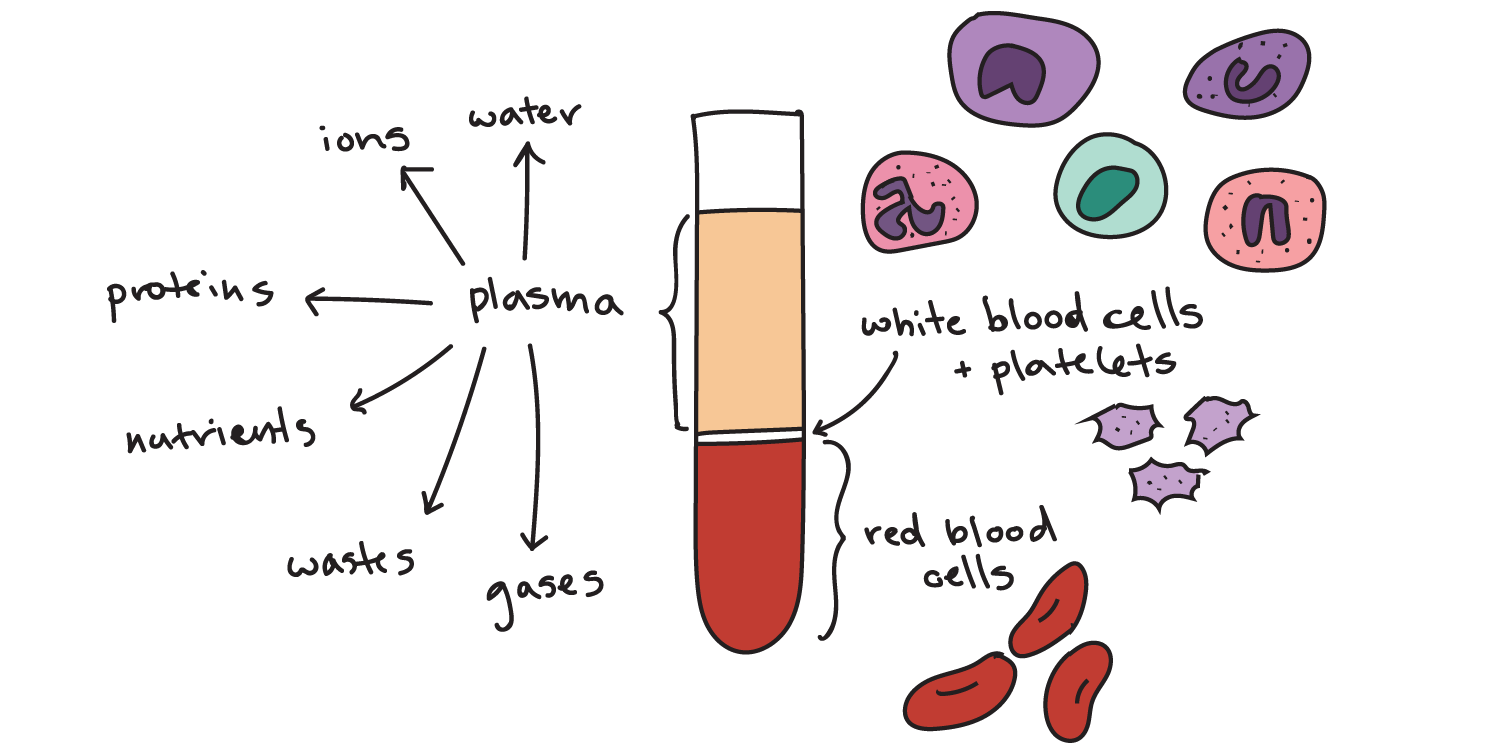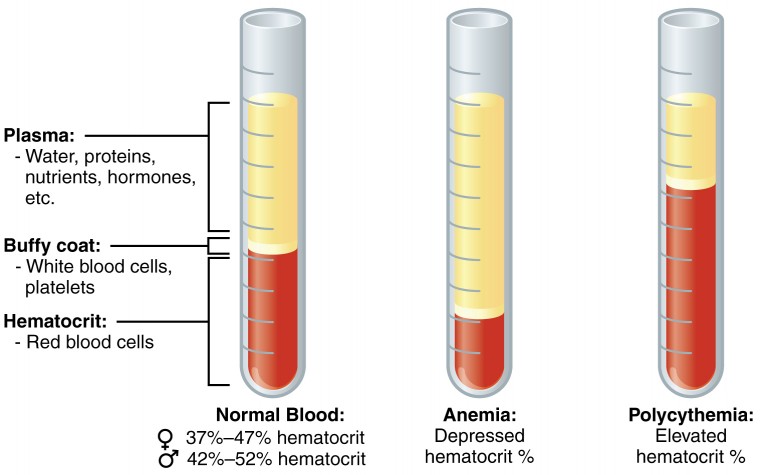Plasma is the liquid component of blood in which the other three components are suspended. Product of bodyfat breakdown 3-20 10 6.

Composition Of Blood And Its Functions
Forming blood clots to prevent excess blood loss.

. Plasma is 92 water and the contents of. The formed elements of the blood are illustrated in figure 133. The cells and cellular components of human blood are shown.
Transport oxygen from lungs to all living tissues of the body and carry away carbon dioxide. The many roles of blood include delivering nutrients and oxygen to cells transporting. Blood has four components.
Transporting oxygen and nutrients to the lungs and tissues. - Erythrocytes contain the pigment hemoglobin which imprts the red color to blood and transport oxygen and carbon dioxide to and from the tissues. Red blood cells comprise about 40 percent of the bloods volume while plasma makes up more than half of the volume.
Specific components of the blood include red blood cells white blood cells platelets and the plasma which contains coagulation factors and serum. Blood has many different functions including. Plasma RBC WBC and platelets are the 4 major blood components.
Plasma accounts for around 55 of blood fluid in humans. White blood cells are. The components of human blood are.
Tap card to see definition. 66-82 10 8. Produced in liver 8-40 10 7.
- A red blood cells that is typically a bioncave disc without a nucleus. Blood is a specialized body fluid. Plasma red blood cells white blood cells and platelets.
Blood is a highly specialized tissue composed of many different kinds of components. Red blood cells made from bone marrow stem cells are crucial for the exchange of oxygen and carbon. It consists of water with several different substances dissolved within.
All humans produce these blood components. These components can be given to different patients which is why we say that a donation of one unit or pint of whole blood can help multiple people. The liquid component of the blood in which the following blood cells are suspended.
This major constituent of blood comprises about 55 percent of blood volume. Carrying cells and antibodies that fight infection. Specific components of the blood include red blood cells white blood cells platelets and the plasma which contains coagulation factors and serum.
Reducing the flow of blood to the injured area. Whole blood is used to help patients in 2 ways. Plasma red blood cells white blood cells and platelets.
Components of Blood and its function. Four of the most important ones are red cells white cells platelets and plasma. The major components of blood include plasma red blood cells white blood cells and platelets.
Components of Blood Plasma. Neurotransmitter of the parasympathetic nervous system. Blood plays a part to keep a human alive belike brain and heart.
Platelets form clots that prevent blood loss after injury. White blood cells leukocytes. Platelets also secrete growth factors autocrine regulatorssee chapter 11 which are important in maintaining the integrity of blood vesselsThese regulators also may be involved in the development of atherosclerosis as described in a later section.
Whole blood can also be separated into its specific components of red cells plasma and platelets. White blood cellsincluding neutrophils monocytes lymphocytes eosinophils and basophilsare involved in the immune response. The main components of blood are.
The extracellular matrix called plasma makes blood unique among connective tissues because it is fluid. 4-43 10 7. - Reddish color is due to hemoglobin.
It can be transfused into a single patient. Blood is important for regulation of the bodys pH temperature osmotic pressure the circulation of nutrients and removal of waste the distribution of hormones from endocrine glands and the elimination of excess heat. Red blood cells also called erythrocytes make up about 40 of the bloods volume.
Blood is important for regulation of the bodys pH temperature osmotic pressure the circulation of nutrients and removal of waste the distribution of hormones from endocrine glands and the elimination of excess heat. In whole blood gcm 3 In plasma or serum gcm 3 Water. Plasma is a straw-coloured liquid.
The cellular elementsreferred to as the formed elements include red blood cells RBCs white blood cells WBCs and cell fragments called platelets. Components of the Blood The Role of Blood in the Body. It has four main components.
Blood cells are classified into the following types. Red blood cells erythrocytes. Click again to see term.
Click card to see definition. Erythrocytes or red blood cells Leucocytes or white blood cells. Solvent 081-086 093-095 Acetoacetate.
Blood transports materials and heat around the body and helps to protect against disease. Plasma is the liquid component of blood in which the red blood cells white blood cells and platelets are. Red blood cells deliver oxygen to the cells and remove carbon dioxide.
These carry oxygen from the lungs to the rest of the body. Energy storage total 31-57 10 4. Tap again to see term.
21 2 Components Of The Blood Concepts Of Biology 1st Canadian Edition

Components Of Blood Article Khan Academy


0 Comments